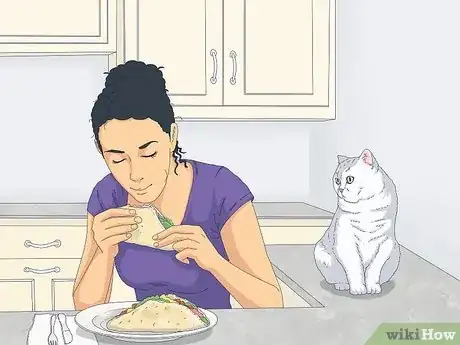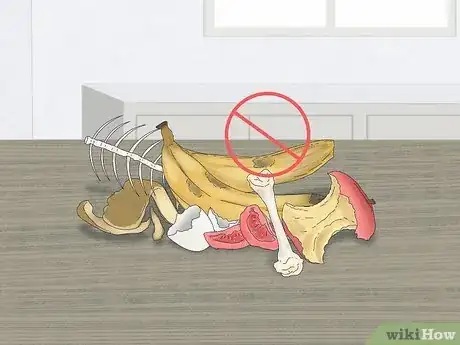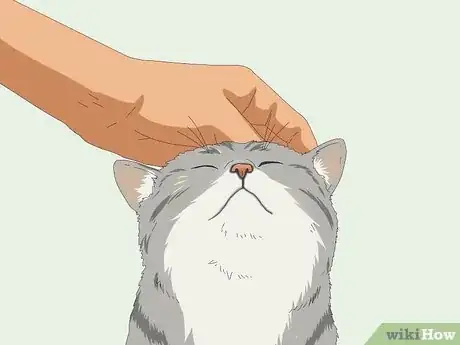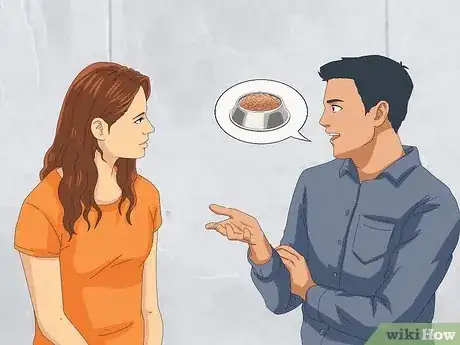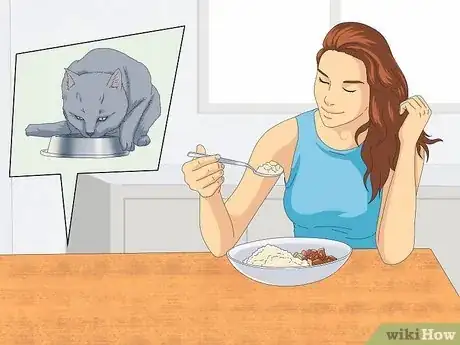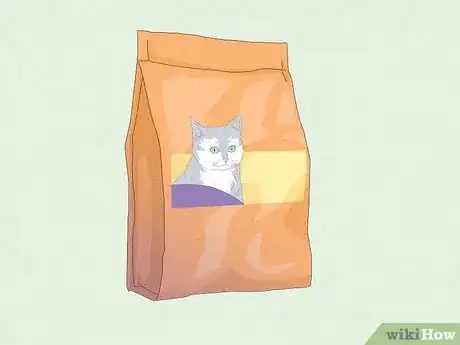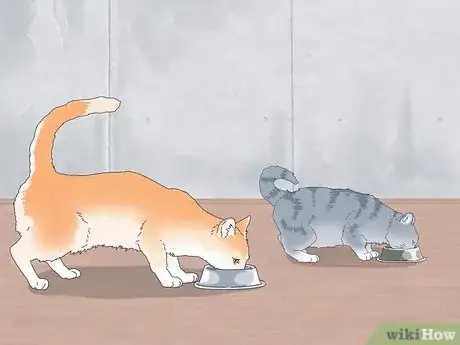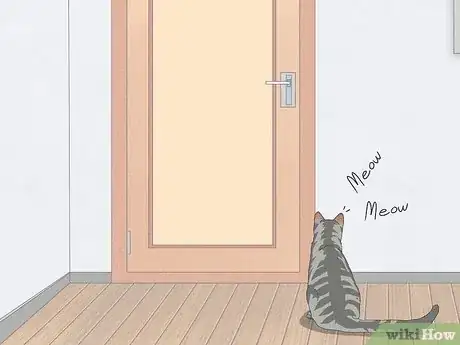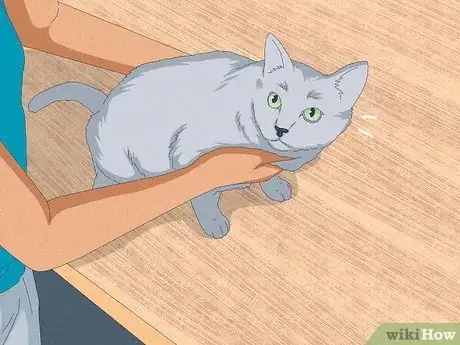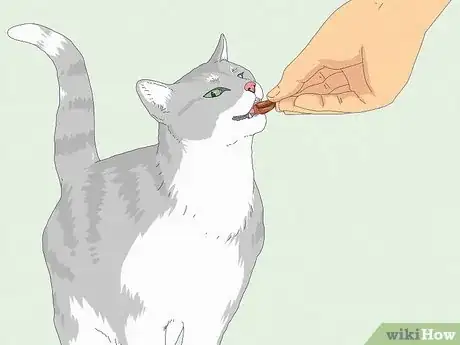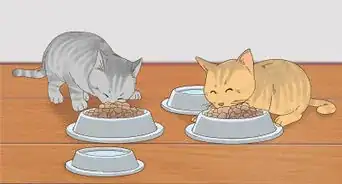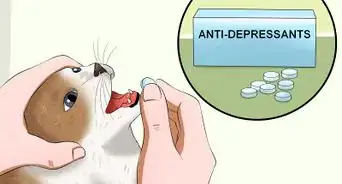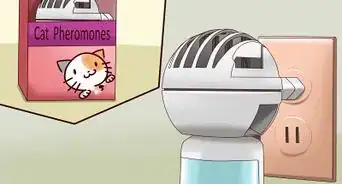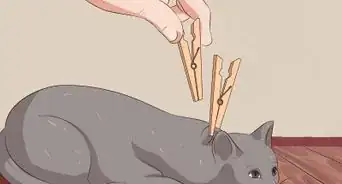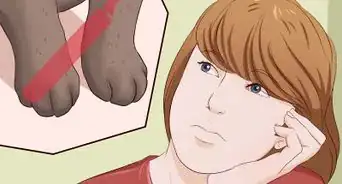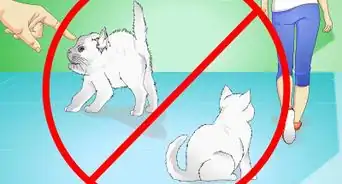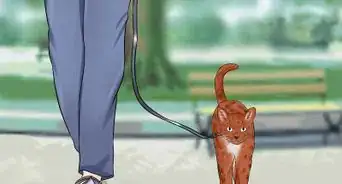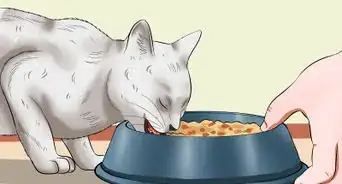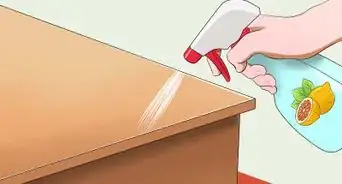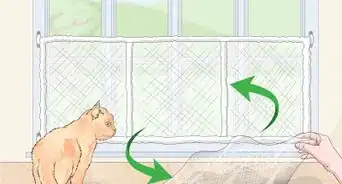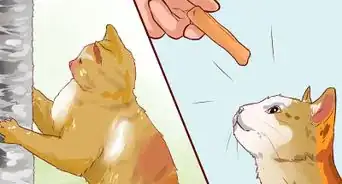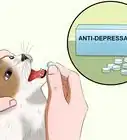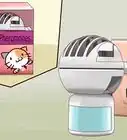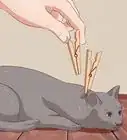This article was co-authored by Ryan Corrigan, LVT, VTS-EVN. Ryan Corrigan is a Licensed Veterinary Technician in California. She received her Bachelor of Science in Veterinary Technology from Purdue University in 2010. She is also a Member of the Academy of Equine Veterinary Nursing Technicians since 2011.
There are 9 references cited in this article, which can be found at the bottom of the page.
This article has been viewed 17,322 times.
It might seem hard to eat without a cat begging, but there are actually many ways to do so. You should start with some basic behavioral adjustments, like never giving your cat table scraps and ignoring your cat during mealtimes. You might also want to adjust how you feed your cat by ensuring it gets enough food and receives its meals on a regular schedule. Finally, you could choose to move your cat away from the dining area while you eat, or train it to stay away on its own.
Steps
Adjusting Your Behavior
-
1Ignore your cat while dining. While dining, do not speak to your cat or play with it. Interaction will shift the cat’s attention to you and what you’re doing. When it sees that you’re eating, it might begin begging for food. To prevent this, do not even look at your cat while dining. Most importantly, when your cat starts begging, do not pay it any attention.[1]
-
2Do not feed your cat scraps. If your cat gets a taste for your leftovers or table scraps – even if you wait to feed your cat scraps after you’re done eating – it will be more likely to beg while you dine. It may also refuse to eat its own food, which can encourage it to beg even more. To eat without a cat begging, don’t share table scraps with your cat.[2]Advertisement
-
3Give your cat more attention. Your cat might be begging while you eat not because it is hungry, but because it wants to play or interact with you. In order to eat without a cat begging, try rolling a ball to your cat, sitting with it on your lap and petting it gently, or dangling a string toy in front of it during the 15-20 minutes prior to your meal. This way, your cat will have had its fill of human contact and seek satisfaction elsewhere.[3]
- If your cat behaved well and ignored you during dinner, you can reward it by giving it another 10-15 minutes of attention after you have finished your meal.
-
4Set rules for your entire household. Consistency is key to the long-term success when attempting to change your cat’s begging behavior. If you have housemates or live with your family, get them on board with your new behavioral strategies. Explain your expectations and urge them to adopt the same approach you have regarding your cat's begging.[4]
Adjusting How Your Cat Eats
-
1Feed your cat at the same you eat. If your cat sees you eating, it might get hungry and beg for food from you. In order to eat without a cat begging, give it food of its own and eat when your cat does. This will distract your cat and discourage it from begging as you dine.[5]
- Additionally, develop a regular feeding schedule. Feeding your cat at the same time each day will, over time, ensure that your cat will get hungry at predictable times.
- Space your cat’s meals out over a reasonable period of time. Provide at least three meals each day, with about five or six hours between meals.[6]
-
2Only feed your cat using a cat dish. Your cat should have its own water bowl and food dish. It should never be fed from regular plates and tableware. Doing so could lead your cat to believe that when you are dining, you’re eating the cat’s food (or food the cat will like). This will make it hard to eat without a cat begging.[7]
-
3Feed your cat enough food. It is possible that your cat is begging because you are not feeding it enough. Talk to your vet to find out how many calories your cat needs each day. Then, check the nutrition label on your cat’s food to find out how many calories you’re actually providing. You may be able to eat without a cat begging by meeting its caloric needs.[8]
- Caloric needs vary according to breed, weight, and age. Your vet will be able to determine what your cat’s caloric needs are.
- Some cats may eat their food and still beg. In this case, give your cat a toy with a treat hidden inside while you eat. This will distract your cat and give it a little extra snack.
-
4Watch your cats as they eat. If you have more than one cat, it is possible that one cat is eating the other’s food. The cat whose food is being eaten might then beg for food as you eat because it is still hungry. If one of your cats begs while you eat, monitor your feline friends the next time you feed them. If you see one cat taking the other’s food, start feeding your cats in separate areas of the house so that the cat whose food is being pilfered can get enough to eat.[9]
Changing Your Cat’s Location
-
1Confine your cat while you eat. If you do not dine in front of your cat, you can eat without it begging. Place your cat in another room and close the door. Alternately, place it in its crate. Then, sit at your dining table and enjoy your meal. When finished, end your cat’s confinement.[10]
-
2Keep your cat off the table. If your cat sits on the dining table – whether you’re dining or not – it will begin to think that it is acceptable to be there. During mealtimes, a cat on the table might be emboldened and start begging for food or even snatch food right off your plate. Prevent this situation by shooing your cat off the table, or physically picking it up and removing it.[11]
- One way to shoo your cat off the table is to spray it with a little water. Fill a spray bottle with water and use it on your cat whenever it is sitting on the table.
- If you have other people living in your home, you can ask them to help you ensure your cat does not sit on the table.
-
3Use training to prevent your cat from begging. Place your cat in a location away from your dining table. Give your cat a treat with one hand and click a clicker (a pet training device) with the other. Repeat four or five times in several different sessions throughout the day. After a week or so, continue to situate your cat in the same place away from your dining area and continue to click the clicker each time you do so, but reduce the frequency with which you administer treats.[12]
- Never give your cat treats less than half the time you use the clicker.
- Eventually, you will be able to click the clicker just before you dine, causing your cat to leave the dining area.
References
- ↑ http://www.catster.com/kittens/How-to-Prevent-or-Stop-Your-Kitten-from-Begging-at-the-Table-34
- ↑ https://petcentral.chewy.com/how-can-i-stop-my-cat-from-stealing-my-food/
- ↑ https://petcentral.chewy.com/how-to-manage-food-aggression-in-cats/
- ↑ http://www.catbehaviorassociates.com/be-consistent-when-training/
- ↑ https://petcentral.chewy.com/how-can-i-stop-my-cat-from-stealing-my-food/
- ↑ https://www.pet-happy.com/cat-wants-to-eat-all-the-time-polyphagia/
- ↑ http://www.catster.com/kittens/How-to-Prevent-or-Stop-Your-Kitten-from-Begging-at-the-Table-34
- ↑ https://www.pet-happy.com/cat-wants-to-eat-all-the-time-polyphagia/
- ↑ https://petcentral.chewy.com/how-to-manage-food-aggression-in-cats/
- ↑ http://www.dailymail.co.uk/news/article-2190527/Cats-beg-suffering-obsession-food-driven-insanity.html
- ↑ http://www.catster.com/kittens/How-to-Prevent-or-Stop-Your-Kitten-from-Begging-at-the-Table-34
- ↑ https://petcentral.chewy.com/how-can-i-stop-my-cat-from-stealing-my-food/
- ↑ https://www.pet-happy.com/cat-wants-to-eat-all-the-time-polyphagia/
About This Article
If your cat begs for food while you're eating, try your best to ignore it since giving it any kind of attention might actually reinforce the behavior. You should also avoid feeding it table scraps or else it will keep begging for food in the future. One trick you can try is feeding your cat at the same time you eat. That way, your cat will be distracted with its own food. You can also try shutting your cat in a separate room during meals so it doesn't have the chance to beg. Either way, always reward your cat with treats whenever it doesn't beg while you're eating, which will help it associate not begging with getting delicious rewards. For tips from our Veterinary co-author, like how to tell if your cat is eating enough every day, keep reading!
